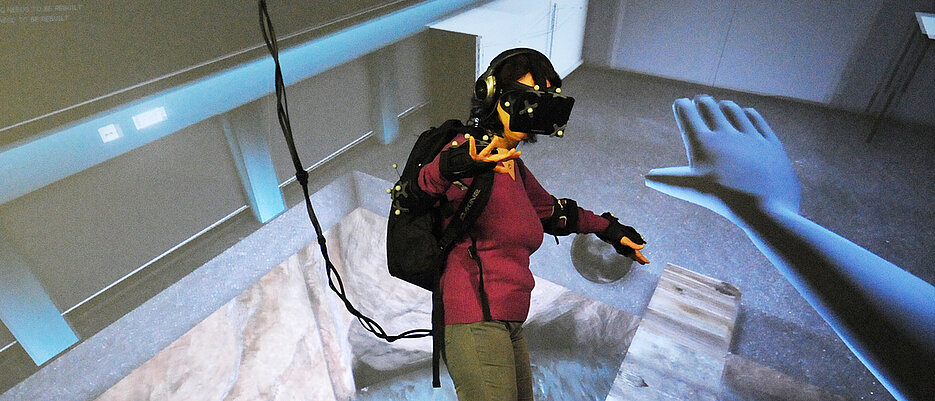CSRankings: Würzburg Computer Scientists at the Top
11/14/2023In a new ranking, Computer Science at the University of Würzburg has achieved very good positions in a number of areas. In one discipline, it is even ranked 1st in Germany.

First place in Germany, third place in Europe, sixth place worldwide: This is the result achieved by the Chair of Human-Computer Interaction at Julius-Maximilians-Universität Würzburg (JMU) in the CSRankings in the research field of Virtual Reality.
CSRankings is a metrics-based ranking of top computer science institutions worldwide. It weights research institutions, faculties and chairs according to their presence in the most renowned journals; Emery Berger, Professor at the College of Information and Computer Sciences at the University of Massachusetts Amherst, is responsible for this.
"The Chair of Human-Computer Interaction at JMU has been conducting research in the field of highly immersive and interactive virtual, augmented and mixed reality systems for over ten years," says Chair holder Marc Erich Latoschik, describing his field of work. "As a member of the Faculties of Mathematics and Computer Science and Human Sciences, we develop innovative computer science solutions with human-centred and evidence-based research in interdisciplinary approaches."
Latoschik and his team cooperate with a large number of partners, in particular the "Psychology of Intelligent Interactive Systems" working group led by JMU Professor Carolin Wienrich, as well as with working groups from psychology and psychiatry, data science, psychological ergonomics, education and external partners such as the Chair of Computer Graphics at TU Dortmund. "This has enabled us to achieve significant visibility at both national and international level over the past ten years," says Latoschik happily.
Top in the Field of "Natural Language Processing"
But other areas of Würzburg's computer science are also ranked highly in the CSR rankings. For example, JMU is ranked 6th in Germany, 30th in Europe and 120th worldwide in the field of Natural Language Processing, primarily thanks to Goran Glavaš, who has held the Chair of Computer Science XII at JMU since summer 2022. Natural Language Processing (NLP) is one of the focal points of his research.
Glavaš essentially pursues three goals with his research: Firstly, he wants to develop sustainable and modular models in the field of NLP that require less computing power, are therefore more resource-efficient and can also be used by smaller units. Secondly, these models should work in a fair and ethically correct manner - i.e. as free of prejudice as possible. And thirdly, these models should be able to transfer the skills they have learnt from English-language text collections, for example, to other languages.
At the Forefront of Computer Vision
Computer Vision is another field in which JMU performs well in the CSR rankings. In this specialised field of artificial intelligence, scientists are working on the question of how computers can be enabled to extract meaningful information from digital images and videos. JMU is ranked 8th in Germany, 25th in Europe and 119th in the world in this field, thanks in part to Radu Timofte, holder of the Chair of Computer Science IV (Computer Vision) and holder of a Humboldt Professorship.
Timofte's work has had a lasting influence on research in the field of Image Super-Resolution (SR). SR techniques can be used to increase the resolution of images and thus improve the perception of information. By using sophisticated imaging models and combining them with modern machine learning methods, Timofte has repeatedly made outstanding contributions to the field of Computer Vision.
His research results form the basis of numerous applications and have already led to a number of industrial projects and start-ups. The image enhancement and processing of smartphones, the design of intelligent cameras, the 3D mapping of road signs, methods for estimating biometric data or pedestrian detectors in intelligent traffic lights are just a few examples that benefit from his calculations.
Centre for Artificial Intelligence and Data Science
The three scientists are members of the university's Centre for Artificial Intelligence and Data Science CAIDAS. Its members conduct research in the fields of Machine Learning, Data Science, Image and Text Analysis, AI Systems, Ethics/Legal/Societal Acceptance, and Economy and Transfer within the four central application pillars: AI for (Life) Science, Human-Centered AI, AI in Digital Humanities, Economics/Law and AI. The methods for these applications are also researched at CAIDAS in the underlying area Foundations of AI and Data Science.
The detailed results can be found here: https://csrankings.org/
Contact
Prof. Dr. Goran Glavaš, Chair of Computer Science XII (Natural Language Processing), T: +49 931 31-81352, goran.glavas@uni-wuerzburg.de
Prof. Dr. Marc Erich Latoschik, Chair of Computer Science IX (Human-Computer-Interaction), T: +49 931 31-85871, marc.latoschik@uni-wuerzburg.de
Prof. Dr. Radu Timofte, Chair of Computer Science IV (Computer Vision), T: +49 931 31-84169, radu.timofte@uni-wuerzburg.de






